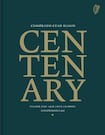
Centenary is the official account of the State's 1916 commemorations, edited by Ronan McGreevy and produced handsomely in bi-lingual format by the Royal Irish Academy on behalf of Government Publications. Covering commemorative events from the centenary of the funeral of Jeremiah O'Donovan Rossa in August 2015 to the national conference held in NUI Galway in November 2016, the main themes of the State's commemorative programme – Historical Reflection, State Ceremonial, the Living Language, Youth and Imagination, Cultural Expression, Community Participation and the Global and Diaspora – each have a dedicated section highlighting many of over 3,500 events held during the period.
Much of the volume’s tone is set by a thoughtful introduction by President Michael D Higgins, for whom the abiding memories of the commemorative year were the rediscovery of women’s role in the Rising and the engagement with children. The former is certainly one of the most striking differences between 2016 and any other historic commemoration, especially previous ones of the Rising such as 1966.
In addition to chronicling the activities of women, through essays and visual images, Centenary's analysis of #Waking the Feminists, also provides an insight into gender relations in modern Ireland. In doing so the book serves a two-fold purpose identified by the President, of reflecting "on who we are as a people" in the 21st century as well as examining how 1916 was commemorated.
0 of 3
Depictions of the national flag and the Proclamation being delivered to schools across the country echoes the focus on children during 1966. The central role of the Irish Defence Forces in such ceremonies highlights the emphasis placed by the State on them as the direct descendants of the Irish Volunteers, the legitimate Óglaigh na hÉireann.
Making children a focus of commemorative events enabled many of the “new” Irish to explore our history, illustrated well in an evocative photo of the senior infants class in a Muslim primary school in Blanchardstown making Irish flags.
The publication also covers a number of events that took place in Northern Ireland, including erecting James Connolly’s statue on the Falls Road, exhibitions hosted by the Ulster Museum, and the innovative graphic novels depicting historical figures from unionism and nationalism produced by Derry’s Nerve Centre. The focus on 1916 in the North was a more holistic one, taking a broader approach to the inter-relationship of the Rising to the Somme in the wider context of the first World War, a theme of Éamon Phoenix’s essay on 2016 in Ulster.
2016 diverged significantly from 1966 in its inclusivity, reflecting the role of all combatants including the British armed forces and the Irish policemen who died in resisting the rebels and whose role was remembered at the unveiling of the Remembrance Wall at Glasnevin and at Grangegorman Military Cemetery. This approach enabled some Unionists to engage with the significance of 1916 as an historical event, seen here by the then UUP leader Mike Nesbitt as an opportunity “to reach out and engage with those whose opinions and aspirations differ from our own”.
While much of the book’s focus is devoted to the leaders, the sections on the new Military Archives Building (a “Permanent Reminder”) show how much more knowledge has been gained about a wider array of rebels from the invaluable Military Service Pensions Collection. The significance of personal pension stories is highlighted in another short essay by President Higgins on his family’s pension experience.
In addition to McGreevy’s commentary on the main commemorative events, there are succinct essays by historians, writers, artists, voices of ordinary citizens and an account of how 1916 was marked by Irish communities globally. Centenary is a one of the best souvenirs of the centenary year and as valuable a commentary on 2016 as on 1916.
In the final chapter, the Minister for Culture, Heritage and the Gaeltacht, introduces Creative Ireland, billed as the "legacy" programme to the 1916 commemorations. Many readers will be left wondering what exactly is Creative Ireland and what is its relationship to historical commemoration and the Decade of Centenaries? The rationale for tagging it on to the end of the 2016 commemorations is far from clear. Is it a way of side-stepping the more awkward commemorations of partition and the Civil War that are to follow and which cannot be commemorated in the same manner as 1916? Maurice Manning, the chair of the government's expert advisory committee on commemorations, sees the Irish as "A people at ease with its history" in the aftermath of 2016. It remains to be seen if that will also be the case in 2023.
Dr Marie Coleman is a senior lecturer in modern Irish history at Queen’s University Belfast












